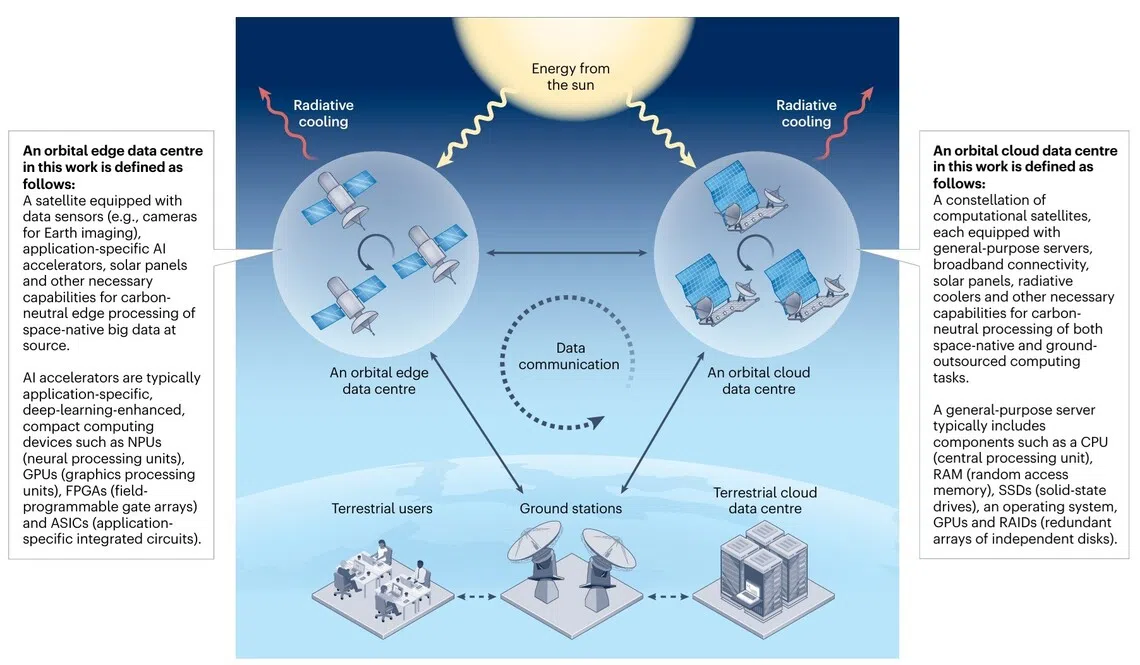Data centres to boldly go where no man has gone before: NTU researchers show the way
The NTU researchers’ study follows a 10- to 20-year forecast from Amazon founder Jeff Bezos for data centres in space

[SINGAPORE] Researchers from the Nanyang Technological University (NTU) have outlined a “practical path” for space-based data centres in a study published in Nature Electronics on Monday (Oct 27).
That could potentially pave the way for sustainable computing with unlimited solar energy and free cooling, said the scientists.
The study followed a forecast from Amazon founder Jeff Bezos earlier this month, in which he predicted that gigawatt-scale data centres could be built in space in 10 to 20 years.
Data centres require large amounts of land, water and energy, while also generating significant carbon dioxide emissions. Carbon-neutral facilities in low-earth orbit, around 160 to 2,000 km above ground, could thus be a solution to all three issues.
NTU researchers claimed that space-based data centres could offer the advantages of “unlimited” solar energy and natural radiative cooling due to the extreme cold. This comes as Goldman Sachs data forecasts a 165 per cent rise in data centre power demand by 2030.
In Singapore, 7 per cent of national electricity is used by data centres; this is expected to rise to 12 per cent by 2030, indicated data from the Infocomm Media Development Authority.
The Republic was also the world’s second most expensive market for data centres in 2024, with costs averaging US$13.80 per watt of load or about US$11.7 million per megawatt according to Turner & Townsend’s data centre cost index.
“By harnessing the sun’s energy and the cold vacuum of space, orbital data centres could transform global computing,” said NTU associate provost for graduate education, Dr Wen Yonggang, who led the research.

In one of the proposed models, imaging or sensing satellites equipped with artificial intelligence (AI) accelerators could process raw data directly in orbit, transmitting only the essential processed information to Earth.
This approach could reduce data transmission volumes by over a hundred times, significantly lowering energy consumption and latency.
Alternatively, constellations of satellites fitted with servers, broadband links, solar panels and radiative coolers could collectively perform complex computing tasks, from scientific simulations to AI model training.
These distributed constellations are technologically feasible with today’s satellite and computing advancements, and could be scaled up over time, said the researchers.
China has already begun exploring such solutions, having launched 12 satellites in May for a space-based computing constellation that could grow to as many as 2,800 satellites.
The research team worked with NTU deep tech spin-off Red Dot Analytics to develop a digital twin model of the space-based data centre.
The model simulated expected power consumption, cooling and solar energy generations. It eventually showed that the cold vacuum of space will allow heat to be released more efficiently than on Earth, said NTU.
Increased emissions due to rocket launches are forecast to be offset within “a few years” of a solar-powered orbital data centre’s operation.
France-based Thales Alenia Space also found last year that sending data centres to space to use solar energy could be a more environmentally-friendly solution.
However, it had cautioned that effective reduction of emissions from rocket launches would require the development of a launcher that emits 10 times less carbon over its lifecycle than existing options – one that does not yet exist.
Decoding Asia newsletter: your guide to navigating Asia in a new global order. Sign up here to get Decoding Asia newsletter. Delivered to your inbox. Free.
Copyright SPH Media. All rights reserved.



